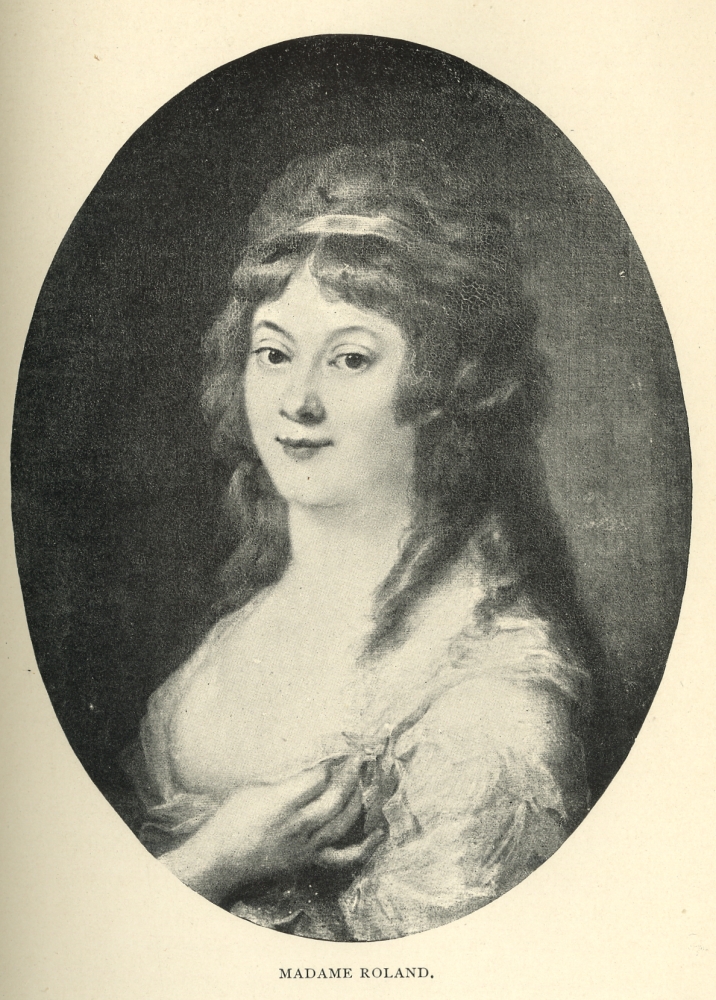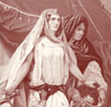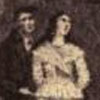William Russell’s short biography of Madame Roland begins with a nightmare
parade of the Terror that followed the French Revolution, in which Madame Roland stands out as “one white-robed figure
in the doleful procession, with pale, bright, classic face, mantled with
dark silken hair, and illumined by deep blue, transparent eyes, kindled
to indignant flame by the hootings and curses of the
multitude” (that is, a
scenario that blends “light into darkness,” the heroine’s appearance, and a
lady’s confrontation of the mob). This
heroine’s sacrifice collapses into that of Marie Antoinette:
the image “dwells in the gazer's memory long after it has disappeared from
the scaffold still wet with the blood of a queen, and been flung, as
carrion, into the common fosse at Glamart” (R 39).
Wilmot-Buxton, too, interlinks Marie-Jeanne or Manon Philipon Roland and Marie
Antoinette, the subject of her preceding chapter:
“life-stories…so unlike…so absolutely opposed politically, become curiously
intermingled…and in the end are merged into the same common fate” (WB 137).
The horrors of the Revolution stain the image of Madame Roland’s heroism, as
they curdle Russell’s prose: her “clear
conscience” largely seems to shine in “an atmosphere of light and purity”
because of the “the contrastive foil afforded by [her] grimed, blood-spotted
companions”; her “courage, energy, devotion” and “cruel and untimely
death…excite the unbounded sympathy and compassion of all” who consider that
she was led astray by “sinister influences surrounding her youth, and the
false lights” that she later followed into “an impassable abyss” (R
39-40).
William Russell’s short biography of Madame Roland begins with a nightmare
parade of the Terror that followed the French Revolution, in which Madame Roland stands out as “one white-robed figure
in the doleful procession, with pale, bright, classic face, mantled with
dark silken hair, and illumined by deep blue, transparent eyes, kindled
to indignant flame by the hootings and curses of the
multitude” (that is, a
scenario that blends “light into darkness,” the heroine’s appearance, and a
lady’s confrontation of the mob). This
heroine’s sacrifice collapses into that of Marie Antoinette:
the image “dwells in the gazer's memory long after it has disappeared from
the scaffold still wet with the blood of a queen, and been flung, as
carrion, into the common fosse at Glamart” (R 39).
Wilmot-Buxton, too, interlinks Marie-Jeanne or Manon Philipon Roland and Marie
Antoinette, the subject of her preceding chapter:
“life-stories…so unlike…so absolutely opposed politically, become curiously
intermingled…and in the end are merged into the same common fate” (WB 137).
The horrors of the Revolution stain the image of Madame Roland’s heroism, as
they curdle Russell’s prose: her “clear
conscience” largely seems to shine in “an atmosphere of light and purity”
because of the “the contrastive foil afforded by [her] grimed, blood-spotted
companions”; her “courage, energy, devotion” and “cruel and untimely
death…excite the unbounded sympathy and compassion of all” who consider that
she was led astray by “sinister influences surrounding her youth, and the
false lights” that she later followed into “an impassable abyss” (R
39-40).
Both
narratives soon open a paragraph with the heroine’s birth in March,
1754 (“a year after Marie Antoinette” [WB 137]), in
Paris, daughter of an engraver. For Russell, the young girl
represents a lesson in ideology, a tug-of-war between her mother’s Christianity and her father’s
“gospel according to Voltaire and Rousseau.”
The father,
“Gratien Philipon,…held the idea of God to be an illusion;
Church and State confederate despotisms, cemented by force and hypocrisy;
the unequal distribution of wealth a crime against humanity…” Both Russell
and Wilmot-Buxton appear to regard the father’s bad character as the root
cause of the subject’s suffering heroism: “the alchemy of a morose and
envious spirit” turned all circumstances into “witnesses against the
providence of God and the justice of man” for this bad father (R 40):
M.Philipon’s resentment of social inequality combined with greed,
intemperance, and speculation led to poverty. His beautiful and intelligent
daughter, the only surviving child of eight, had no future without “rank and
wealth” (R 40-1). Like many a hypocritical politician, M.Philipon was a
domestic despot who wasted family resources in “low debauchery” (R 41); only
his wife Margaret Binant, prudent, faithful, beautiful, stayed the
family’s “downward progress” and protected the precocious daughter from evil
influence. Having established the parental characters, Russell turns to the
topic of talent:
Jeanne Manon's educational progress was
singularly rapid. At four years of age she read perfectly, without clearly
remembering, she says, the process by which that faculty was acquired; and,
assisted by competent instructors, she became, whilst yet the merest girl,
sufficiently mistress of the ordinary accomplishments, as well useful as
ornamental, that made up the education of a carefully-nurtured daughter of a
Paris shopkeeper. Mademoiselle Philipon had a finely-toned, vibrating voice,
and was passionately fond of choral harmony, a power and taste which led to
her constant attendance at church, where the imposing pomp of the Catholic worship, with its effective
accessories of magnificent music, illuminated altars, gorgeous processions,
aided by the constraining example of her mother's blameless life, gave a
strong but ephemeral bias to the as yet ductile mind of the enthusiastic
young maiden. Writing nearly thirty years afterwards in her
prison-cell at Ste. Pelagie, Madame
Roland says, "At eleven I found myself deeply
religious; at sixteen I was a philosopher; at twenty a sceptic.” (R
41-2)
Russell illustrates the bad tone of Catholic practice as well as bohemian
irreverence in society of France at
that period. He describes a mock catechism of the little girl by an artist
in her father’s studio, and an incident when the girl took a translation of
Plutarch to church during Lent: “To her girlish,
undisciplined apprehension, the heroes of the classic biographer were
incarnations of the loftiest attributes of humanity; the despotic
democracies which they championed, communities of freemen—model republics!”
This love of classical ideals shows that “this young person” could not have
felt “true reverence” for the far different ethos of “the religion of
humility and compassion, which teaches, in precise opposition to the Greek
and Roman morality, that meekness, not pride—mercy, not vengeance…” (R 43).
Wilmot-Buxton, who places discussion of Manon’s reading after the episode of
illness that we turn to next, regards Plutarch as a high point of the girl’s
avid reading rather than a corrupting influence: “This book, with its series
of noble lives, its vivid pictures of Greece and Rome, not only
opened a new world to the little maiden; it made her a Republican” (WB 140).
Wilmot-Buxton is less the advocate of Christian moral progress, and cuts
quickly to the anecdote that Russell in due course relates as well: an
illness that defines character. “One of the scenes
which the woman of forty, waiting for death in her wretched cell, remembered
most clearly was an early contest of will between her father and herself”
(WB 138). “Whilst her brain was still throbbing with the
fresh enthusiasm kindled by the magic pages of Plutarch, an illness,
requiring to be promptly dealt with, attacked her, and she was ordered to
take some extremely nauseous medicine: she refused to do so, and twice her
father, in spite of Madame Philipon's remonstrances, severely whipped her”
(R 43). Wilmot-Buxton presents a scene in which Manon is trying to swallow the
smelly dose when her father flies into a rage at her “obstinacy” and whips
her. When Manon “hardened herself and declared amidst
sobs and tears that she would try no more to swallow it,” the father whipped
her the second time. It was the threat of a third whipping that roused the
Spartan spirit, in both versions: “As the threat left M.
Philipon's lips, the resolution of the imitative Spartan girl was taken; her
cries and tears ceased instantly, and turning towards her father, with a
look of calm disdain, she deliberately repeated her refusal to swallow the
medicine, lifted her clothes with her own hand, and invited him to fulfil
his threat! Madame Philipon now resolutely interposed…” (R 43). Russell’s
version ends in a reconciliation of the nurturing mother and docile
six-year-old patient. Wilmot-Buxton concludes with direct quotation of the
common source, Madame Roland’s own memoir: “’They might have killed me on the
spot’…’without my uttering so much as a sigh; nor will it cost me more
to-day to ascend the guillotine than it did then to yield to a barbarous
treatment” (WB 138).
In both narratives, the father rather than the child is conquered by this
incident; the mother is allowed to manage the girl’s upbringing: “Madame
Philipon's precepts and example must about this time have obtained a signal
ascendancy” (R 44) over her daughter's mind. In both narratives, Manon becomes
a devout Christian, her vocation confirmed when, as her first communion
approached in 1764, she begged to be allowed to enter a
convent: she spent a year as a lay boarder at the “Convent of the Congregation, a building which stood
next the prison in which she was afterwards to be confined” (WB
141). A child given to religious raptures, she turned her passions in more
“natural channels,” friendships with another girl pupil and a lay nun (WB
142). From the convent she went, in the following year, to live with her
grandmother and aunt. For Russell, this is from the frying pan into the
fire, from torrid saints’ legends to Voltaire and
Rousseau, reading “by the aid whereof the Christian maiden
rapidly grew—or ought I to write, shrank?—into a strong-minded jeune philosophe, with a strong tendency, helped by
the unquiet spirit of the time, towards ultra-democratic theories of civil
polity” (R 45). Manon recalled taking offense at the patronizing treatment
of grandes dames and the familiarity of servants when she was taken on
visits to great houses. A visit to Versailles “inflamed” her republicanism, her desire for “freedom
and equality”; Russell exclaims: “Error! Mademoiselle
Philipon! Illusion ! jeune philosophe, and of a
gross and very common-place kind.” Not only were the Romans “aristocratic
despots,” but someone of her rare talent should never aspire to be equal to
the ordinary crowd (R 46).
Both Russell and Wilmot-Buxton turn to the description of the young
marriageable woman, Russell emphasizing her influence on all who beheld her,
including merchants and suitors. She rejected a
prosperous butcher: "What! shall I, who have
lived with Plato; with all the philosophers, unite myself with a
shopkeeper!" Russell compares various descriptions of Manon’s
beauty, “with considerable diversity of colouring…. Lamartine says she was
of tall, lithe figure, had black silken hair, blue eyes, the nose of a Greek
statue, superb teeth, a beautiful smile, and a melodious voice. The
pen-and-ink sketch drawn by her own hand is a curious specimen of
self-painting:—‘I am five feet five inches in
height, have a well-made leg, and my foot is well set on; my chest is
broad and nobly decorated. My carriage is graceful, and my face has a
great deal of colour, with much softness and expression. No single
feature, perhaps, is strictly beautiful, but taken together could not
but please. My mouth is a little wide, you may see a prettier every day,
but not one with a smile more tender and engaging. My eyes are fine and
well opened, and the colour of the iris is hazel; and my look is open,
frank, tender, varying in expression with the emotions of the
affectionate heart of which it indicates the movements, and if, serene
and lofty, it sometimes astonishes, it charms much more. My hair is dark
brown; my nose I used to think too full at the end, but taken with the
rest, especially in profile, it is not amiss’" (R 48).
Manon lost the protection and guidance of her mother, who had held the family
business together. Her father brought his mistress into the home, and Manon
sought some dignity and independence in the convent. Her old friend from Amiens introduced
M.Roland, “a well-descended gentleman of ability, fortune, and
literary tastes, who had long held the important post of Inspector of
Manufactures” (R 49), who impressed Manon with his easy manners and
learning, in spite of his age. Roland proposed marriage, but was
discouraged by M.Philipon’s refusal to give his daughter’s hand to someone
who openly disapproved of M.Philipon’s irregular living arrangement. Manon
was disillusioned and embittered when M.Roland accepted this rejection and
went away, but in due course he returned to the convent and urged Manon to
marry him; the wedding took place in 1780; they had one daughter,
Eudora. “The wedding tour of M. and Madame Roland
extended to Switzerland and England, with which last-named
country and its institutions Madame was upon the whole reasonably satisfied,
seeing ‘that in England man at least was something’" (R 51).
From Roland’s
estate in Amiens, and then near Lyons (Russell and Wilmot-Buxton differ
in their accounts of the estate and the political developments), and in
recurrent trips to Paris, Madame Roland
participated in the political changes that led to the Revolution. M. Roland was
elected to the newly revived National Assembly and became Minister of the
Interior, and Madame Roland actively hosted salons and wrote for the
Girondists. Wilmot-Buxton follows closely the stages of the catastrophe, with excerpts
from Madame Roland’s correspondence, detailing her
personal conflicts with Danton—“her bête noir
Danton exclaim[ed], ‘Why not invite Madame Roland to the Ministry too?
Everyone knows that Roland is not alone in office’”—and
Marat—“the envenomed eyes of Marat and his friends were on her
with no friendly gaze,” ready to seize evidence that the Rolands were
traitors to the cause against the King (WB 156).
Russell is less interested in the political history, emphasizing rather the
erring heroine’s drama:
Madame herself was the real minister whose
hand traced the official letters, dispatches, the telling reports and
speeches, which her husband copied and read; albeit Madame herself only
modestly claims "to
have infused into her husband's writings that union of gentleness, of
reasoning and sentiment, which only a woman can combine." That
troubled and fantastic dream has passed away; and now, towards the close of
1793, the deputies of the Gironde, having celebrated their
last supper—a profuse banquet, brilliant with lights and flowers, and
enlivened by wine and eloquent speeches, to be thereafter carefully
reported, touching the possibility of God and Immortality,—have followed
Louis to the scaffold; and Madame
Roland herself, who might, like her husband, have escaped the clutch of the
assassins, but disdained to do so, has been arrested, and awaits in St. Pelagie the purely formal and
inevitable decree of death, amusing herself meanwhile in writing memoirs,
and passionate appeals to the Terrorists for justice in the name—poor prisoned maniac!—
of the sacred principles consecrated by the Revolution! Riouffe
and other prisoners were enthusiastic in their admiration of the unquailing
courage of the queenly woman. "Ah," sadly replied her female attendant, "you do
not know all: before you, Madame calls up all her courage, but when in
her own room, she sometimes stands for hours together, leaning against
the window and weeping bitterly." (R 52)
Wilmot-Buxton’s vivid, detailed account of the events of this period,
which included Madame Roland's repeated imprisonment and release,
interconnects this heroine with the story of Charlotte
Corday, whose assassination of
Marat sealed the fate of the imprisoned Girondistes.
Russell appears eager to get to the climax of execution:
At length, on the 9th November,
1793, Madame Roland stood before Fouquier Tinville's
tribunal; was not, of course, permitted to be heard, and received sentence,
which, upon returning to the prison, she communicated to her fellow captives
by passing her hand sharply across her throat. Early on the following morning, the
still beautiful woman—she was in her thirty-ninth year only, and the
peculiar character of her physiognomy reduced her apparent age by at least
ten years—was bound in a cart, and slowly conveyed to
execution. She was habited in a white muslin robe, her dark abundant tresses
waved freely in the wind, and a smile of haughty scorn curled her
finely-chiseled lips as they murmured, in reply to
the hooting crowd who continued to shout "A la guillotine ! a la
guillotine!"—"I am going to the guillotine; they who send me
there will soon follow, and you will hoot them also."
Lamarche, an old man, fettered in the same cart, was
overwhelmed with terror, which Madame Roland strove vainly to dispel, and
passing a tall column, on the summit of which a statue of Liberty had been
placed, she exclaimed, "O Liberty, what crimes are committed in thy name!" Another
expression, of much greater significance and interest, is not so well
known:— "Can I have
pen and paper?” she said, addressing the official who received her at
the foot of the scaffold; “I would, if possible, write down the strange
thoughts that are rising in my mind." The request was brutally
refused, and a few moments afterwards Madame Roland had thought her last on
earth!
The best evidence of the true womanly worth of Madame Roland is
seen in the effect which her execution produced upon the minds of her
husband and servants. M. Roland, as his
wife predicted he would, slew himself a few hours after the intelligence
reached him, "finding it impossible to live in a world where such a crime
was permitted." Two servants, a man and woman, burst, in a paroxysm of grief
and rage, into Fouquier Tinville's hall of doom, and denounced
him and his myrmidons to their faces as villains and murderers. The woman
was held to be insane, and dimwitted; the man's audacious tongue was
silenced by the guillotine! (R 53)
Wilmot-Buxton repeats Madame Roland’s last words about liberty. “So died
the heroine of the Revolution, the representative of all that was fine
and pure and good in that great movement towards liberty and the rights
of Man.” Her name is “spoken of
with awe and gratitude in the country which owes so much to her generous
devotion, her single-hearted love, her untiring patriotism” (WB 163).
















